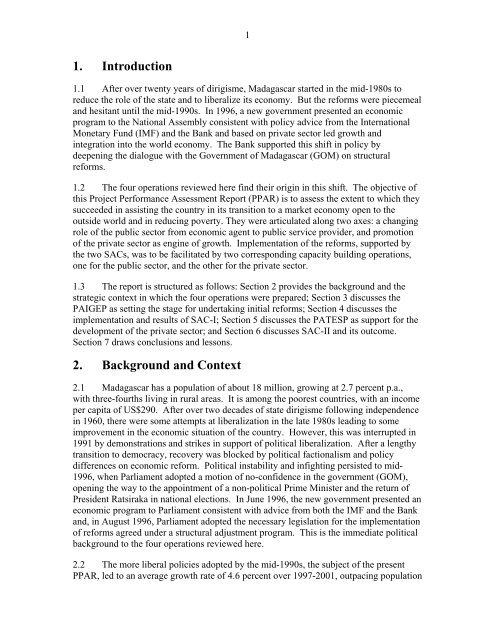Download Report - Independent Evaluation Group - World Bank
Download Report - Independent Evaluation Group - World Bank
Download Report - Independent Evaluation Group - World Bank
You also want an ePaper? Increase the reach of your titles
YUMPU automatically turns print PDFs into web optimized ePapers that Google loves.
11. Introduction1.1 After over twenty years of dirigisme, Madagascar started in the mid-1980s toreduce the role of the state and to liberalize its economy. But the reforms were piecemealand hesitant until the mid-1990s. In 1996, a new government presented an economicprogram to the National Assembly consistent with policy advice from the InternationalMonetary Fund (IMF) and the <strong>Bank</strong> and based on private sector led growth andintegration into the world economy. The <strong>Bank</strong> supported this shift in policy bydeepening the dialogue with the Government of Madagascar (GOM) on structuralreforms.1.2 The four operations reviewed here find their origin in this shift. The objective ofthis Project Performance Assessment <strong>Report</strong> (PPAR) is to assess the extent to which theysucceeded in assisting the country in its transition to a market economy open to theoutside world and in reducing poverty. They were articulated along two axes: a changingrole of the public sector from economic agent to public service provider, and promotionof the private sector as engine of growth. Implementation of the reforms, supported bythe two SACs, was to be facilitated by two corresponding capacity building operations,one for the public sector, and the other for the private sector.1.3 The report is structured as follows: Section 2 provides the background and thestrategic context in which the four operations were prepared; Section 3 discusses thePAIGEP as setting the stage for undertaking initial reforms; Section 4 discusses theimplementation and results of SAC-I; Section 5 discusses the PATESP as support for thedevelopment of the private sector; and Section 6 discusses SAC-II and its outcome.Section 7 draws conclusions and lessons.2. Background and Context2.1 Madagascar has a population of about 18 million, growing at 2.7 percent p.a.,with three-fourths living in rural areas. It is among the poorest countries, with an incomeper capita of US$290. After over two decades of state dirigisme following independencein 1960, there were some attempts at liberalization in the late 1980s leading to someimprovement in the economic situation of the country. However, this was interrupted in1991 by demonstrations and strikes in support of political liberalization. After a lengthytransition to democracy, recovery was blocked by political factionalism and policydifferences on economic reform. Political instability and infighting persisted to mid-1996, when Parliament adopted a motion of no-confidence in the government (GOM),opening the way to the appointment of a non-political Prime Minister and the return ofPresident Ratsiraka in national elections. In June 1996, the new government presented aneconomic program to Parliament consistent with advice from both the IMF and the <strong>Bank</strong>and, in August 1996, Parliament adopted the necessary legislation for the implementationof reforms agreed under a structural adjustment program. This is the immediate politicalbackground to the four operations reviewed here.2.2 The more liberal policies adopted by the mid-1990s, the subject of the presentPPAR, led to an average growth rate of 4.6 percent over 1997-2001, outpacing population
















